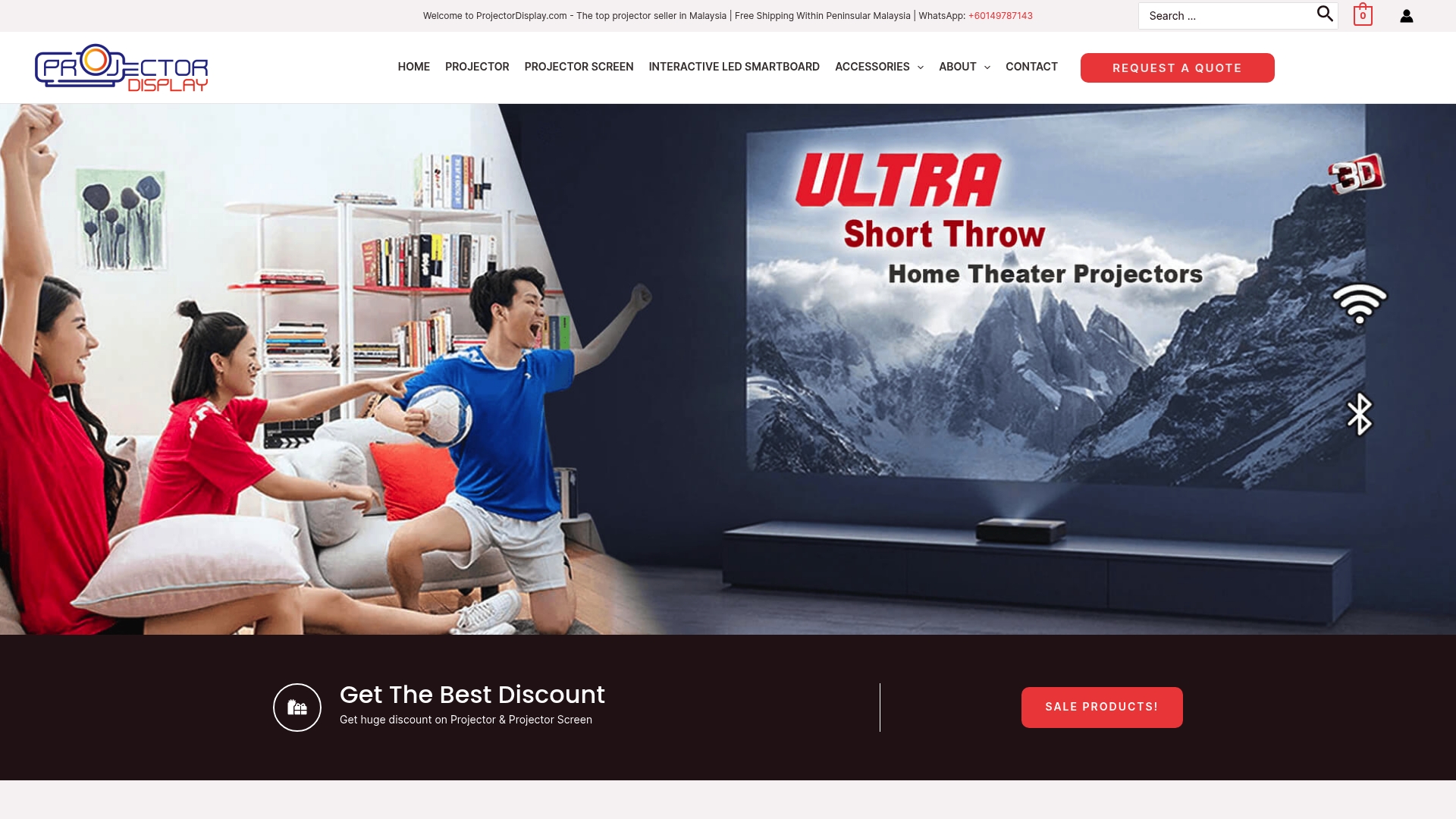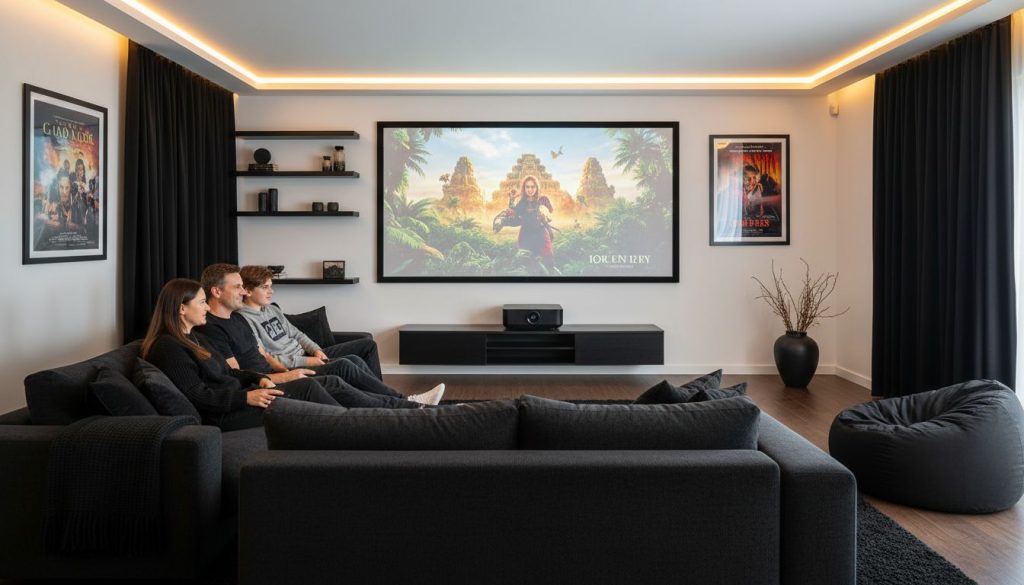Did you know that even a few inches can make or break your projector setup? Choosing the right throw ratio is the difference between crisp, wall-filling visuals and a tiny, misplaced picture. Some projectors can deliver a 100-inch screen from only three feet away, while others need much more space. Grasping how throw ratio works helps you maximize your image size and ensures your projector fits your room, whether it's a classroom, home theater, or office.
Table of Contents
- Defining Throw Ratio in Projector Technology
- Types of Throw Ratios and Their Differences
- How Throw Ratio Impacts Image Size
- Calculating Throw Ratio for Your Space
- Choosing the Right Throw Ratio Projector
- Common Throw Ratio Mistakes to Avoid
Key Takeaways
| Point | Details |
|---|---|
| Understanding Throw Ratio | The throw ratio is the ratio between projector distance and image width, crucial for selecting the right projector. |
| Types of Projectors | Projectors fall into three categories: standard, short, and ultra short throw, each suitable for different environments. |
| Space Assessment | Accurate measurements of room size and projector placement are vital for achieving the desired image dimensions. |
| Common Errors | Avoid choosing a projector that mismatches your space, as it can lead to unsatisfactory image quality or positioning issues. |
Defining Throw Ratio in Projector Technology
A throw ratio represents the critical mathematical relationship between a projector's placement and the resulting image size. According to research from Wikipedia, throw ratio is defined as the precise ratio between the distance from a projector's lens to the screen and the projected image's width.
Understanding throw ratio is essential for selecting the right projector for your space. The calculation helps determine exactly how far you need to position your projector from the screen to achieve your desired image dimensions. For instance, a projector with a 1.5:1 throw ratio means that for every 1.5 feet of distance from the screen, you'll generate one foot of image width.
Throw ratios vary significantly across different projector models and types. Some key variations include:
- Short-throw projectors: Designed for closer screen distances, typically with ratios around 0.5:1
- Standard-throw projectors: Traditional models with ratios between 1.5:1 and 2.5:1
- Long-throw projectors: Ideal for large venues, with ratios exceeding 3:1
When planning your projection setup, carefully consider your available space and desired screen size. Understanding optimal projector distance can help you make the most informed decision for your specific environment.
Types of Throw Ratios and Their Differences
Projectors are categorized into three primary throw ratio types: standard throw, short throw, and ultra short throw. According to research from ProjectorScreen.com, these categories have distinct technical specifications that determine their optimal usage scenarios.
Standard throw projectors dominate traditional meeting rooms and home theater setups. These projectors typically have throw ratios between 1.5:1 to 2:1, meaning they require more distance from the screen to generate a large image. They work best in spacious environments with significant room between the projector and the projection surface.
Short throw projectors are designed for more compact spaces. With throw ratios ranging from 0.38:1 to 1.4:1, these projectors can create large images from much closer distances. They're ideal for:

- Small conference rooms
- Classrooms with limited space
- Home entertainment areas with restricted mounting options
- Environments requiring minimal projector-to-screen distance
Ultra short throw projectors represent the most advanced projection technology. Featuring throw ratios below 0.5:1, these projectors can be placed extremely close to the screen while generating expansive visual displays. Understanding the projector throw distance calculator can help you precisely determine the right setup for your specific needs.
Here's a summary of the key differences between projector throw ratio types:
| Throw Ratio Type | Typical Ratio Range | Ideal Use Cases | Image Size at 4 ft Distance |
|---|---|---|---|
| Ultra Short Throw | Below 0.5:1 | Small rooms Home theaters Tight spaces |
80"+ |
| Short Throw | 0.38:1 – 1.4:1 | Classrooms Small conference rooms Home use |
50"–70" |
| Standard Throw | 1.5:1 – 2.5:1 | Large rooms Auditoriums Traditional setups |
20"–32" |
How Throw Ratio Impacts Image Size
According to research from Projector1.com, the throw ratio is a critical factor that directly determines the projected image size based on the projector's distance from the screen. A simple mathematical relationship exists between the projector's placement and the resulting visual display.
Imagine you have a projector with a 1.5:1 throw ratio. This means for every 1.5 feet of distance from the screen, you'll generate one foot of image width. So if you place the projector 9 feet away from your screen, you'll create a 6-foot wide image.
This calculation becomes crucial when planning your projection setup in different environments like home theaters, conference rooms, or classrooms.
The impact of throw ratio on image size becomes even more nuanced when considering different projector types:
- Standard throw projectors: Require 10-15 feet for a 100-inch screen
- Short throw projectors: Can create a 100-inch screen from just 3-4 feet away
- Ultra short throw projectors: Generate large images from mere inches from the screen
When selecting a projector, it's essential to measure your available space and match it with the appropriate throw ratio. What Is Throw Distance? can provide additional insights into making the perfect projection setup for your specific environment.
Calculating Throw Ratio for Your Space
According to research from eHomm Projector, calculating throw ratio is a straightforward process that involves dividing the distance from your projector to the screen by the desired image width. This simple mathematical equation helps you determine the perfect projector placement for your specific room configuration.
Let's break down the calculation step by step. If you want a 100-inch screen and have 12 feet of available space, you'll divide the total throw distance (12 feet) by the screen width. Assuming a standard 16:9 aspect ratio, a 100-inch screen is approximately 87 inches wide. Converting this to feet means dividing 87 inches by 12, which gives you a throw ratio of approximately 1.5:1.
To ensure an accurate calculation, follow these key steps:
- Measure the exact distance from your projector's lens to the screen
- Determine the precise width of your desired projection area
- Divide the throw distance by the screen width
- Compare the result with manufacturers' recommended throw ratio ranges
Pro tip: Always leave some extra space for adjustment. Slight variations in room setup or screen positioning can impact your final throw ratio. Understanding the projector throw distance calculator can provide additional precision in your measurements and help you make the most informed decision for your projection environment.
Choosing the Right Throw Ratio Projector
According to research from ProjectorScreen.com, selecting the right throw ratio is a critical decision that depends entirely on your specific room dimensions and intended projection setup. The throw ratio you choose can dramatically impact your viewing experience, making it essential to match the projector's capabilities with your available space.
Different environments demand different throw ratios. Home theaters with expansive walls can accommodate standard throw projectors, while compact meeting rooms or classrooms require short throw alternatives. Your room's depth, ceiling height, and potential mounting locations all play crucial roles in determining the most suitable projector type.
Consider these key factors when selecting your ideal throw ratio:
- Room size: Measure the total available distance between potential projector placement and screen location
- Screen dimensions: Determine the desired image size you want to achieve
- Mounting flexibility: Evaluate where you can physically place the projector
- Ambient lighting: Consider how throw ratio impacts image brightness in your specific environment
Short Throw vs Long Throw: Choosing the Right Projector for You can provide additional insights to help you make the most informed decision for your unique projection needs.
Common Throw Ratio Mistakes to Avoid
According to research from eHomm Projector, one of the most critical errors people make is selecting a projector with an inappropriate throw ratio for their specific space. This seemingly simple mistake can completely derail your projection setup, resulting in images that are either too small, awkwardly positioned, or impossible to focus correctly.
Many users underestimate the importance of precise measurements when planning their projection environment. Failing to account for room depth, ceiling height, and potential mounting locations can lead to significant disappointment. For instance, purchasing a standard throw projector for a small conference room might mean the image won't fit on the screen, or the projector will need to be placed in an impractical location.
Here are the most common throw ratio mistakes to steer clear of:
- Ignoring room dimensions: Measuring your space accurately before purchasing
- Overlooking mounting constraints: Considering ceiling height, wall space, and potential obstructions
- Miscalculating screen size: Ensuring the throw ratio matches your desired image dimensions
- Forgetting about lens shift: Understanding how lens adjustment impacts projection placement
7 Essential Tips for Choosing a Projector for Classroom Use can help you navigate these potential pitfalls and make a more informed projection equipment decision.
Find the Perfect Projector Throw Ratio for Your Space Today
Choosing the right projector throw ratio can feel overwhelming when you consider room size, screen dimensions, and mounting options. The challenge is real—without the correct throw ratio, your image could be blurry, too small, or even impossible to set up properly. Whether you need a short throw for a cozy classroom or an ultra short throw projector for tight living spaces, understanding this key concept is critical for an enjoyable viewing experience.

At ProjectorDisplay.com, we specialize in helping you match the ideal projector to your unique environment. Explore a wide selection of high-quality projectors including short throw, laser, and smart models designed for home theaters, business presentations, and educational use. Don't wait to transform your space into a perfect visual experience. Visit our site now to discover expert advice, fast shipping within Peninsular Malaysia, and dedicated customer support ready to guide you through every step of your purchase.
Start by understanding more about Optimal Projector Distance and how to Calculate the Right Throw Distance for your setup, then find the projector that fits your exact needs at ProjectorDisplay.com. Your perfect image is just a click away.
Frequently Asked Questions
What is throw ratio in projector technology?
Throw ratio is the mathematical relationship between the distance from a projector's lens to the screen and the width of the projected image. It's calculated by dividing the distance from the projector to the screen by the image width.
How does throw ratio affect image size?
The throw ratio directly impacts the size of the projected image based on how far the projector is placed from the screen. For example, a projector with a 1.5:1 throw ratio produces a 1-foot wide image for every 1.5 feet of distance from the screen.
What are the different types of throw ratios for projectors?
Projectors are generally categorized into three types based on their throw ratio: short throw (0.38:1 to 1.4:1), standard throw (1.5:1 to 2.5:1), and ultra short throw (below 0.5:1). Each type is suited for different room sizes and environments.
How can I calculate the throw ratio needed for my room?
To calculate the necessary throw ratio, divide the distance from the projector to the screen by the desired image width. This will help you find the right projector that fits your space and meets your image size requirements.

